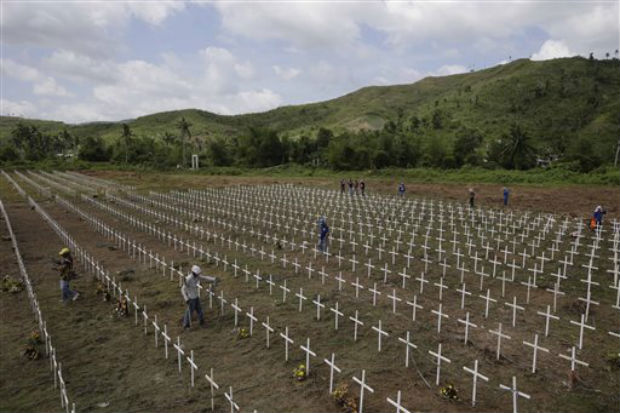Yolanda areas: ‘The recovery is remarkable’

Workers erect wooden crosses at a mass grave for thousands of typhoon Haiyan victims in preparation for the observance of its 1st anniversary in the outskirts of Tacloban City on Wednesday, Nov. 5, 2014. Tens of thousands of people are expected to descend on mass graves, where bodies were dumped chaotically in the weeks after the disaster to prevent disease, for highly emotional vigils on Saturday’s one-year anniversary. AP/BULLIT MARQUEZ
DAGAMI, Leyte—In some ways, the recovery has been remarkable.
Tacloban, the biggest city in Eastern Visayas and among the worst hit, again resembles many other chaotic Philippine urban hubs, with traffic jams, busy market stalls, packed shopping malls and queues at fast-food outlets.
In the countryside, lush green paddies are testament to successful rice planting campaigns that have sustained millions, while local and international aid agencies are helping to build thousands of new houses.
“We’re really happy, things will be a lot more comfortable,” Marianito Abrematea, 57, a farmer in the tiny village of Dagami, told Agence France-Presse (AFP) as he took a break from building his new, concrete-brick house funded by the Red Cross.
Like nearly all his 300 neighbors, Abrematea’s house was destroyed in the storm and he has been living for the past year in a hut made of thatched palm leaves.
“Now we’ll have houses of GI sheets (corrugated iron) and concrete, we won’t be so scared,” he said.
Billions of dollars from the government and aid groups are being poured into the typhoon-hit region in an effort to help people living there, who make up more than 10 percent of the country’s population.
Big successes
Some of the big successes of the campaign have been the restoration of electricity within a few months, quick replanting of crops and sanitation programs that prevented major outbreaks of killer diseases.
The determination of the survivors to quickly rebuild their lives, and not become reliant on aid, has astonished many foreign relief workers, even those with experience in many other disaster zones across the world.
“The resilience of the Filipino people is amazing, they are like phoenix birds,” Camelia Marinescu, International Federation of the Red Cross and Red Crescent Societies chief in Tacloban, told AFP.
Many foreign aid workers also praise the national and local governments’ efforts, as well as their capabilities.
“If this had happened in some other countries in the region, the recovery would certainly not be like this,” Peter Agnew, a senior official with the United Nations Food and Agriculture Organization in Tacloban, told AFP.
Yet, there are no miracle shortcuts to the grinding slog of recovery and the reality is many millions of people face years, or even the rest of their lives, enduring Yolanda-exacerbated misery.
The government’s master plan envisages moving roughly 1 million people away from coastal areas that are deemed vulnerable to storm surges by the middle of 2016, when President Aquino’s term ends.
Snail’s pace
But those plans have already fallen behind schedule, amid problems in finding new land that is safe and suitable for 205,000 new homes, and frustration is building at the speed of the reconstruction program.
“The pace is not very fast. It’s snail-paced unfortunately,” Vangie Esperas said, a councilor with the Tacloban city government, as she toured a fledgling new town with temporary shelters but no running water or power.
“Many of our brothers and sisters are still living in tents and some of them are in temporary shelters,” she said.
President Aquino has also expressed frustration at some of the delays, which is partly due to an infamous government bureaucracy, recently labeling some of the setbacks “absurd.”
The government also acknowledges the region’s economy will take many years to recover, largely because the two most important sectors—coconut farming and fishing—were ruined for millions of people.
No end to grieving
The average household income in the region was already 25 percent less than the national average before the typhoon, according to government data, and this has significantly worsened.
“There’s no question in my mind the poor are poorer than they were before the typhoon,” Save the Children Philippine country director Ned Olney said.
And for many survivors who lost family or friends, the grieving will never end.
Tens of thousands of people are expected to descend on mass graves, where bodies were dumped chaotically in the weeks after the disaster to prevent disease, for highly emotional vigils on Saturday’s one-year anniversary.